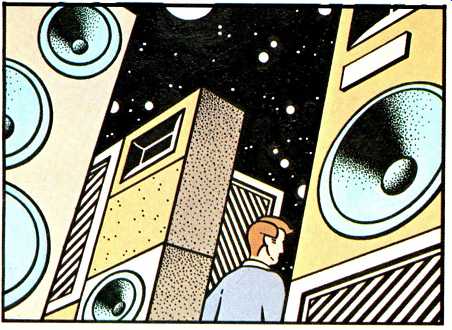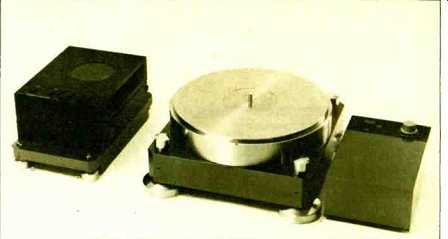
There is never a dearth of new loudspeaker designs at any Con sumer Electronics
Show. But while many loudspeakers are demonstrated, few are worth listening
to for more than a minute or two. To me, it is rather incredible to walk into
audio demo rooms at the Convention Center and into room after room at the Jockey
Club and be subjected to so much really poor sound. In many cases, there are
basic design flaws in the loudspeakers that are the root of the trouble. Other
loudspeakers have some merits, yet the demonstrations are so badly handled
it is impossible to reach any conclusion. When the speakers and the demonstrations
are both poor, you get a sort of "sonic symbiosis" that produces
a cacophonous assault on one's hearing. Boomy bass, peaky midrange, screeching
high frequencies, poor or nonexistent imaging, no perception of depth, and
out-of-phase conditions are commonly encountered in these demonstrations. The
majority of the personnel conducting these demonstrations have no musical sensibility
and obviously have no experience with live music in the concert hall. How else
to explain their poor choice of recordings and general disregard of musical
values? It is apparent that far too many companies have forgotten the basic
purpose of hi-fi components, to afford a psychoacoustic approximation of a
live musical event. High fidelity components are not an end unto themselves,
but a medium for the enjoyment of mu sic.
After having encountered so much terrible sound, it was such a pleasure to walk into the Shahinian Acoustics room and refresh my ears with some really superb music. Dick Shahinian really loves great music, and his knowledge of high-quality classical recordings is encyclopedic. He manages to obtain many original EMI recordings and many other hard-to-get foreign pressings. He chooses the best of these for his demonstrations of his excellent Obelisk speakers, which themselves are models of fine musical balance, accurate imaging, good depth, and wide dynamic range.
Dick's Obelisk speaker has been brought to a high state of refinement with such things as a new polypropylene cone woofer, a 1 7-inch cambric dome midrange and two 3/4-inch polyamide dome super-tweeter units, and a complex new crossover network. This middle-sized (27 inches high by 14 inches wide by 12 inches deep) speaker has claimed frequency response of 32 Hz to 21 kHz, plus 2 dB, minus 3dB. Although the bass response is remarkably good for such a small speaker, Dick had crossed over the unit at 80 Hz and combined it with his latest product, the Contra-Bombarde subwoofer.
The Contra-Bombarde design is more than 20 years old and is the brainchild of none other than Stewart Hegeman. Yes, the same Stu Hegeman who designed the Citation power amplifiers and other forward-looking audio products. This subwoofer is a twin conical slot-loaded stereo horn, with a horn path length of more than 20 feet from throat to mouth.
It was originally the bass portion of the Hegeman Pro loudspeaker, which among other things was noted for its unique upward-firing tweeter which looked like a paper tulip cup! The horn construction is incredibly complex and must be very accurately built if it is to function properly. Ultra high density Finnish birch is used for making the horn and is an aid in resonance suppression.
Twin 8-in. drivers with quite stiff, but not massive, cones are used, with 2-in., high-temperature voice-coils and extra heavy magnets. In other words, the Contra-Bombarde is Stu Hegeman's classic horn subwoofer, brought up to date with modern materials and drivers. Response extends to 16 Hz and power handling is 150 watts/channel, with short peak ability to 750 watts/channel. Dick Shahinian was using various recordings with ex tended bass response, including my own Virgil Fox organ recordings, to really shake the rafters with a very clean bass of tremendous power and impact. At $1,250, the Contra-Bombarde isn't cheap, but one should remember this is a stereo subwoofer. Availability is slated for May 1981.

-------- Micro Seiki's air suspension turntable, Model SX-8000.
Many people favor the transparency and transient attack of electrostatic loudspeakers. The Acoustat full-range electrostatic speaker with built-in, direct drive tube amplifier has enjoyed good sales for some years now, but a new embodiment of the design may generate even greater sales. The Acoustat Model Two uses the same full-range electro static driver elements as the earlier Acoustat speakers. The big difference is that it does not have the built-in, direct drive tube amplifier, but instead uses what Acoustat calls the MK-121 Magne Kinetic Drive System. Essentially, this is an impedance-matching transformer as used in other electrostatic loudspeakers but with some significant differences.
Most objections to transformers in the past had to do with their generation of spurious resonance or "ringing" and difficult impedance and voltage matching.
The MK-121 uses two physically and electrically different "push-pull" transformers with some passive components, and the design allows the circuit to operate in a quasi-parallel band-over lap manner. In other words, there is a low-frequency transformer which operates from the low end of the spectrum and a high-frequency transformer optimized to operate from the top of the spectrum downwards. The transformers over lap at a median frequency of about 1,500 Hz. The result is much higher efficiency than possible with any single transformer, far less distortion, and an impedance which never drops below 3 ohms. Most importantly, the MK-121 permits the use of standard solid-state and tube amplifiers.
Most audiophiles generally shy away from equipment with built-in amplifiers, preferring to use their own favorite amplifier. The Model Two Acoustat is said to reach SPL of 108 dB with amplifiers of 50 to 100 watts per channel, so this should appeal to many who have always wanted to try electrostatic loudspeakers.
I believe the Model Two in the Acoustat room was being driven by a Bedini 100 W/channel Class A amplifier. Listening to a Philips recording of some Rossini Overtures, I was impressed by the ultra smoothness of the first violins, the clarity of the woodwinds, and the sharp attack of the percussion, along with fine imaging and an exceptional perception of depth.
After weary hours of speaker auditioning at the Jockey Club, with one's ears protesting against further abuse, blessed respite can always be found at the B&W suite. Here is an oasis of good taste and good music, where genial John Bowers presents his new products in his inimitable low-key fashion with no hype, no fanfare, no outrageous claims. Superb classical music and carefully selected pop music played through the various B&W loudspeakers are his eloquent spokesmen.
B&W's range of loudspeakers continues to grow. The 802 is now well into production and has found good acceptance from music lovers who like the sound of the 801, but 'do not have the space for this system. Speaking of the 801, like EMI and Decca, I now have adopted the 801 as my "official" monitoring speaker, and it goes along with me on all my remote and location recordings. I also take along 120 pounds of Levinson ML-3 amplifier, which can be burdensome, but the combination is superb and has elicited much favorable comment. At the WOES, B&W introduced their new DM-16 loudspeaker.
This is the successor to the DM6, the first linear phase speaker made in Europe. Because of the "stepped" design, used to place all the driver units in the same acoustic plane, it was known familiarly as the "pregnant whale." The DM-16 is much more graceful and elegant while maintaining the concept of linear phase response.
The DM-16 features a new 220-mm woofer with a thermoplastic cone whose profile was derived from laser interferometry studies. The 2-in. voice-coil is high-temperature Nomex. The midrange driver is the identical unit used in the 801, and the tweeter a derivative of the 801 unit, but employing a flat plate driver. The crossover network is a 4th-order Butterworth type, similar to the unit in the 801. The-3 dB point is 60 Hz, and there is an audio-activated protection circuit.
The sound of this new DM-16 has a close family resemblance to the 801, very smooth and clean, with highly de tailed midrange and exceptional imaging and depth. Bass is clean and solid but does not have the extension of the larger systems.
Of other loudspeaker systems noted, Brian Cheney was on hand with his VMPS Super Tower, sporting new polypropylene midrange drivers. Poor Brian had gone to the trouble of acoustically treating his demo room with Sonex (about which I'll soon be bringing you a detailed report), and visitors found his sound very impressive, until some over zealous CES official told him the Sonex did not conform to regulations (Bah! The Bureau of Standards uses it in their laboratories) and made him remove it.
KEF is another dependable oasis of tranquility and good music. Raymond Cooke's lads always have a selection of high-quality recordings (of which Sir Malcolm Arnold's "Symphony No. 1" on EMI ASD 3823 was quite outstanding for its dynamic impact). As heard on their new Model 303 Series 2 and Model 304 Series 2, the sound was impressive for its smoothness combined with excel lent definition. Both speakers employ a new 1-in. tweeter developed through KEF's by-now-famous computer-aided design techniques. The Model 303 has a single 8-in. mid/bass unit; the some what larger Model 304 has two of the 8-in. drivers and is capable of 107 dB SPL. A unique cosmetic feature of both speakers is a "wrap-around" grille cloth covering all sides of the enclosures, which can quickly be interchanged among six different colors.
Not to be outdone, JBL has a new floor-standing speaker, the L 150A, which also employs laser holography in its design. The system has a new very lightweight phenolic-dome tweeter coated with aluminum. It features a 1-in. copper voice-coil and a 2-lb. magnet. The columnar-shaped system has a 5-in. mid range, and its 12-in. woofer has a 3-in. copper voice-coil and 10-lb. magnet. A passive radiator is used to extend low frequencies, and a computer-designed network provides crossovers at 1.1 kHz and 3.7 kHz. This system is in the JBL tradition, with plenty of punch, but it also has a very clean and extended bass response as well as smooth and well-de tailed high-frequency response.
The winner in the audio exotica sweepstakes has to be the new Micro Seiki air suspension turntable SX- 8000.
The 48-lb. stainless-steel turntable platter is mounted on a solid zinc base, and a remote air pump supports the oil-immersed central shaft on a thin layer of air. It is claimed the tremendously compressed air damps all platter resonances. This is a belt-drive model with the drive motor and electronics in a re mote unit. Up to four arms can be mounted on the turntable base. This can guarantee you one-upmanship for a mere $10,000! Wish I had room for more, but ....
-----------
(Adapted from: Audio magazine, May 1981; Bert Whyte )
= = = =